Comprehensive Anticipatory Design
Less can truly be more. Building a home that requires less money, effort, and materials is more.
A dome shelter that provides more safety in both earthquakes and severe storms is more desireable.
Comprehensive Anticipatory Design
Less can truly be more. Building a home that requires less money, effort, and materials is more.
A dome shelter that provides more safety in both earthquakes and severe storms is more desireable.
![]()
There is a lot of talk about "green" building and "sustainable" building. EconOdome dome kits are designed to be completed by anyone,
What design criteria would you add to this list?
To build a substantial concrete floor above the river rock gravel without building "throw-away" concrete forms, Set concrete blocks in a circle that is a few feet bigger that the dome you want to build. Level the blocks by digging out some dirt where the blocks are too high. Buckminster Fuller avocated "comprehensive anticipatory design".
Sustainability is just one of many "design criteria" that should be applied to the building of our homes.
with or without prior construction experience.
This is just one of many design criteria that have evolved over a period of thirty years.
Buckminster Fuller promoted "comprehensive anticipatory design".
Another way to say this is, "We should think about everything when we design anything".
The EconOdome building system does this. The design criteria include, but are not limited to the following.
1. Economy.
2. Structural Stability.
3. Largest interior volume with the smallest surface area.
4. Ease of construction.
5. Built with renewable resources.
6. Good indoor air quality.
7. Adaptable to lower cost conventional items such as doors, windows, skylights, cabinets, showers, etc.
8. Adaptable to changing lifestyles.
9. Low maintenance.
10. Durable over time.
11. Light and bright interior with plenty of windows and skylights.
12. Fire safer.
13. Resiliant and earthquake safer.
14. Aerodynamic and high wind tolerant.
15. Energy efficient.
17. A joy to live in due to the interior layout and awesome architecture.
We could add community living and increased security.
Following this line of thinking we might end up:
Building ten-sided dome homes and arranging them as below to solve some urban problems.
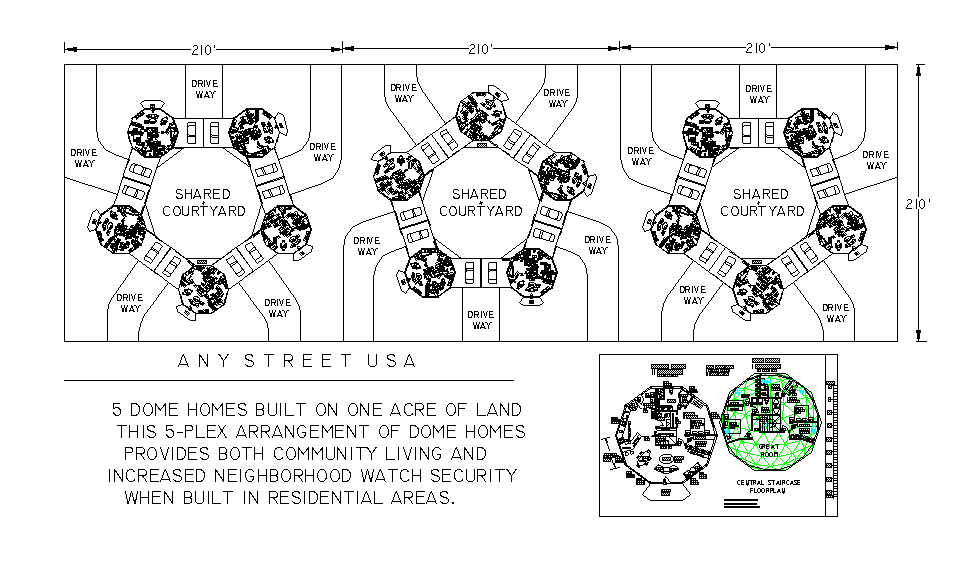
The majority of dome kits are assembled either by using metal hubs at the connection points (nodes)
or by prefabbing the individual triangles (with exterior wood sheathing attached) and bolting the triangles together.
Both of these methods have drawbacks.
If you use a metal hub at each node where 5 or 6 triangles meet,
then you will have a void in the vicinity of every triangle tip.
This often is a problem when installing the interior triangular sheetrock panels.
If you bolt the triangular frames together,
adjacent panels do not connect to the same framing member (strut).
This type of dome would have expansion-contraction where the panels join.
The sheetrock on the interior would develop cracks where the panels join.
And, the exterior of this type of dome is normally shingled
to deal with the expansion-contraction that occurs at the seams
where the separate pre-fabbed triangle frames are joined.
And shingling any building is difficult as there are so many shingles to install.
Other dome types cover the exterior with hand applied or sprayed on concrete.
This is also difficult and the results depend on the skill of the applicator.
With a concrete covered dome, cracks can develop in unpredictable locations.
What is solution? The solution comes from answering another question.
How do you normally build a home? Answer: You cut the boards to fit.
If all the struts are cut-to-fit and joined at the nodes
by stitching the nodes together with stainless steel screws
and also by criss-crossing every node with tensioned stainless steel straps,
the entire dome building will be strong and have no expansion contraction problems.
Why? Answer: Wood (lumber) does not change in length due to humidity or temperature changes.
There is no overall expansion or contraction of the triangulated dome framework.
Covering the EconOdome roof with large lapping triangular shingles
creates an attractive and industrial quality residential dome roof.
There are many proven roofing methods for sealing the exterior.
We can help you by presenting roofing options for your consideration.
I have found it difficult for many reasons to use metal studs for making dome home kits.
Metal stud struts cannot be compound cut on the ends.
This situation does not allow for alignment as the dome is assembled.
And the ends of the struts do not support compressional loading like wood struts do.
Metal struts also provide a conduction path for heat and cold. This is not good.
And, there is the expansion-contraction (due to temperature variations) problem with metal.
And, personally I like handling and looking at wood. Each piece of lumber is natural and unique.
I am totally in favor of using struts made of wood (lumber) for these and other reasons.
Ventilation assists with keeping wood structurally sound and
ventilation also can help with making a building more energy efficient.
The exterior siding on the vertical walls can be spaced away from the sheathing
to allow for ventilation under the siding.
And, the exterior covering on the sloping triangles of the dome can also include a vent space.
If the vent spaces under the siding and under the roof align,
then the entire surface of a dome home can be ventilated.
This ventilates heat away in the summer and provides a buffer zone in the winter.
Spacing the siding and roofing away from the insulated surface of the building
also allows moisture to have an evaporation path and purges unwanted heat.
Cor-a-Vent strips along the lower perimeter of the siding
create a large area ventilation intake that also keeps the bugs out.
Strips of mostly scrap plywood are attached over the plywood sheathing
to create a ventilation space under the entire exterior surface.
An exhaust vent is installed near or at the top of the dome building.
Having the ventilation space outside the building frame
allows you to insulate within the shell cavity with any type of insulation.
Spray in foam insulation works best as it fills every nook and cranny.
With economy foremost in mind we suggest considering building dome homes
using 2x4 construction.
At one time it was necessary to use 2x6 and larger framing members (struts)
to frame a dome roof truss.
The EconOdome frame, however, has shorter and thus stronger struts.
All the insulation need not be installed between the framing members.
You can have a "well insulated" home using 2x4 exterior frame construction.
The exterior walls and roof do not need to be framed with thicker 2x6 or 2x8 lumber
if rigid insulation sheeting is installed outside the building frame.
Also, you may not be fully aware that plywood or OSB is nailed on the entire exterior
of nearly all homes in order to make the building rigid and stable.
However, if the building frame includes internal bracing (triangulation),
Then the building will be sturdy before any sheeting is installed.
Realizing this allows insulation sheeting to be installed directly over the framing.
Doing this also insulates the building frame and prevents wood sheathing from
being "captured" between layers of insulation. Not allowing wood sheathing
to ventilate can possibly lead to mold if any moisture soaks into the sheathing and cannot dry.
The solution is to ensure that all wood sheathing can ventilate.
Or, the solution is to not use any wood sheathing on the exterior of the building.
Commercial buildings use a cover sheet over insulation sheeting on the roof surface.
Then the cover sheet is covered with a durable thermoplastic membrane.
TPO and PVC are two durable thermoplastic membranes that can be cut into shingles.
An amazing feature of thermoplastic shingles is that the laps can be molelecularly bonded.
This means your roof will not blow off in a storm.
And, both TPO and PVC shingles can be tenaciously bonded to a cover sheet.
Since 2021 EconOdome panel kits include cover sheets made with mold resistant sheetrock.
The cover sheet and rigid insulation sheeting is connected to frame with screws and washers.
Doing this eliminates the need to have a ventilation space outside the insulation sheeting.
This is the same type of roof system that is used on commercial building like hotels and factories.

Plywood or OSB sheeting can be very useful to form a ventilation space under the siding and roofing.
However, because an EconOdome building frame is formed by securing triangles at their endpoints.
--plywood to brace the EconOdome building frame--is not necessary!
The triangles form interlocking arches.
More triangles are integrated into the framing of the riser walls.
Criss-crossed metal straps hold the building secure in high winds, deep snows, and earthquakes.
The EconOdome building frame is comprised of triangles formed with precision cut lumber,
and, held secure with metal screws, straps, and a cable.
The surface of the building can be covered and sealed
while standing on the sturdy EconOdome framework.
You will be making an expanding umbrella
that will keep your building materials dry during construction.
Most dome home built with EconOdome kits are waterproofed with large lapping TPO shingles.
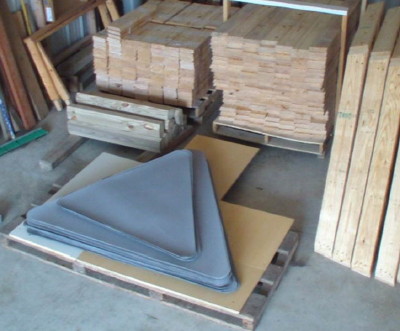
TPO shingles are fully adhered to the exterior panels with contact glue at the factory.
The overlaps are molecularly bonded by fusing/melting with a heat gun & small roller.

Normally, it is difficult to build a floor for a building because building codes often require
a perimeter concrete footing to extend below the frostline in order to prevent the building
from moving when the ground freezes. However, there is a better way to construct a floor and foundation
for a lightweight and balanced dome, without using a massive perimeter concrete footing.
In some areas of the USA a family can build a highly energy efficient and storm safer
38.5' diameter 2,000 square foot dome home with a radiantly heated concrete floor
using just 7 cubic yards of concrete (our mesa base floor and foundation).
In other areas building codes require that all buildings have a conventional foundation
using 30 cubic yards of concrete that is mostly used under the perimeter of the building.
And such a conventional monolithic foundation is very energy inefficient due to perimeter heat loss.
As concrete costs $100 per cubic yard, this is a big difference.
And using 4 times as much concrete costs at least 4 times as much in labor.
Building costs are high for many reasons. Some costs we can control.
If cost is a major concern, then you may want to consider building
with our more economical 2x4 Basic EconOdome frame kit.
And you may want to consider installing a skylight near the top of the dome instead of having a cupola.
Every time you make a choice it is very possible that you are adding to the cost of your home.
If we help you to build a dome home, it is going to be very elegant,
even if you choose to always make the most economical choice.
We call our product the EconOdome kit---because it can be---not because it will be.
I just want to make sure you are aware of cost when you make choices.
If certain things are worth the additional cost to you,
then by all means we want you to have what you want.
After all is said and done
it will be your home
for a long time to come.
You can build a substantial concrete floor above a retained river rock "mesa base".
It is best if the mesa base is about 8 inches high and extends about 3 feet outside of the dome perimeter.
The Backyard Dome is 24 feet in diameter with a 12 foot radius.
This means the round and level pile of gravel could be about 30 feet across with a 15 foot radius.
Rock can be easily "chuted" into place, if it is delivered by a "redi-mix" truck.
To keep weeds and grass from growing up thru the gravel, lay landscape fabric
on the ground prior to putting the gravel in place if this is possible.
we suggest that you make a perimeter treated wood base using treated 2x8 lumber to contain a concrete floor.
This is done by putting two layers of treated 2x8 boards flat on the gravel surface,
with the boards cut to fit and lapped at the ten corners.
The top surface of these "permanent concrete forms" will be 3 inches above the gravel surface.
A concrete floor can then be poured flush to the top of the treated boards.
The "permanent concrete forms" are installed to be flush with the outside perimeter of the riser wall kit.
The "Permanent Concrete Forms" (PCFs) are secured to the concrete floor by installing lag bolts
on the inside edge of the PCFs. We advise that the concrete floor is reinforced with wire mesh,
or, that the concrete be fiber reinforced redi-mix.
You can make the PCFs yourself with locally obtained materials, or,
we can supply you with a "Permanent Concrete Form" kit.
Now let's build an earthquake and storm safer home using some photos taken in Illinois in 2009.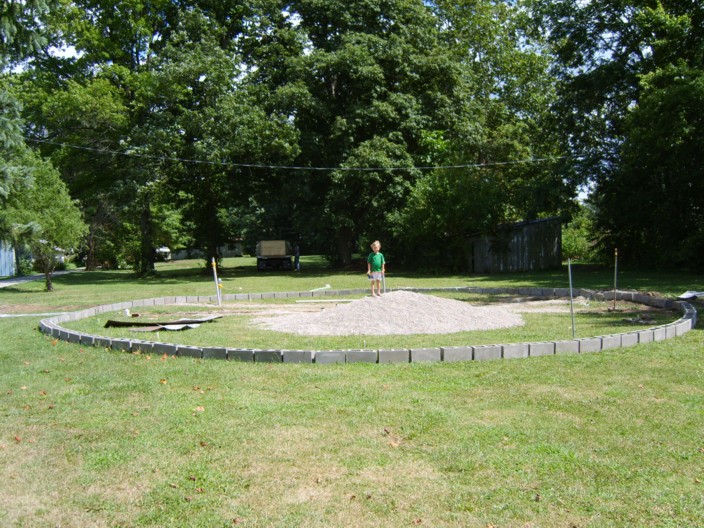
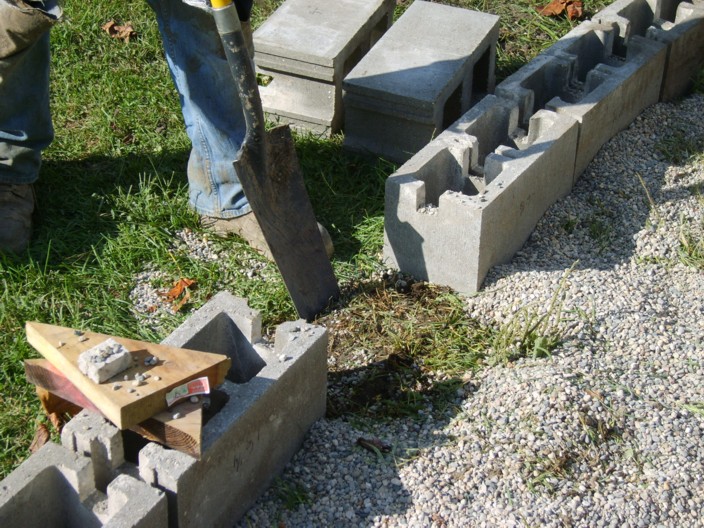
Add extra blocks if necessary to accomodate the slope or to accomodate an abundance of rubble.
Space the blocks about an inch apart.
Cut notches in the top of the blocks and lay-in a ring of epoxy coated rebar.
Fill the blocks with concrete to secure the rebar and blocks permanently in-place.
Put some plastic mortor mesh against the inside surface of the blocks
to keep the gravel from escaping thru the spaces between the blocks.
Then fill the cylinder with river rock or concrete rubble.
You have just created a level and raised mesa that will keep your concrete floor high and dry.
Install the permanent concrete forms and dome base using treated 2x8's lapped at the corners.
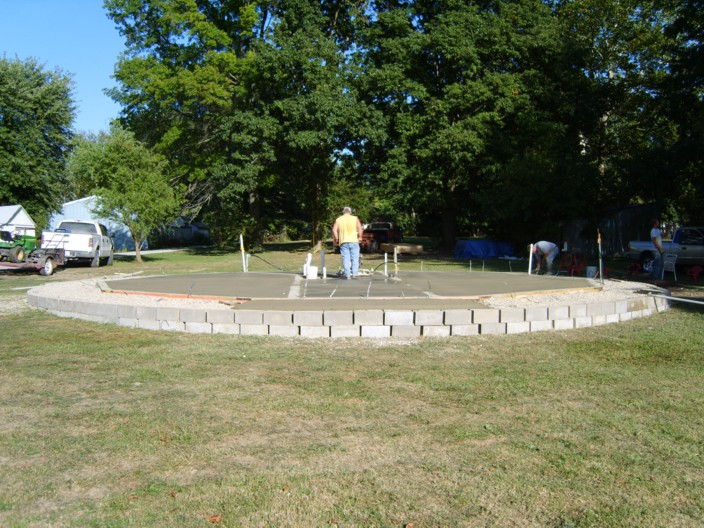
Then pour three inches of fiber reinforced concrete to make your floor and secure your dome base.
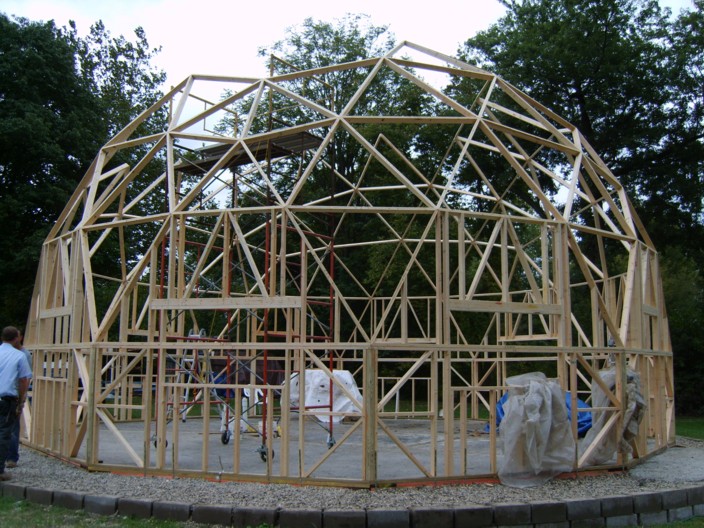
Now you can frame your dome using a precision-cut EconOdome Basic 2x4 Frame Kit.
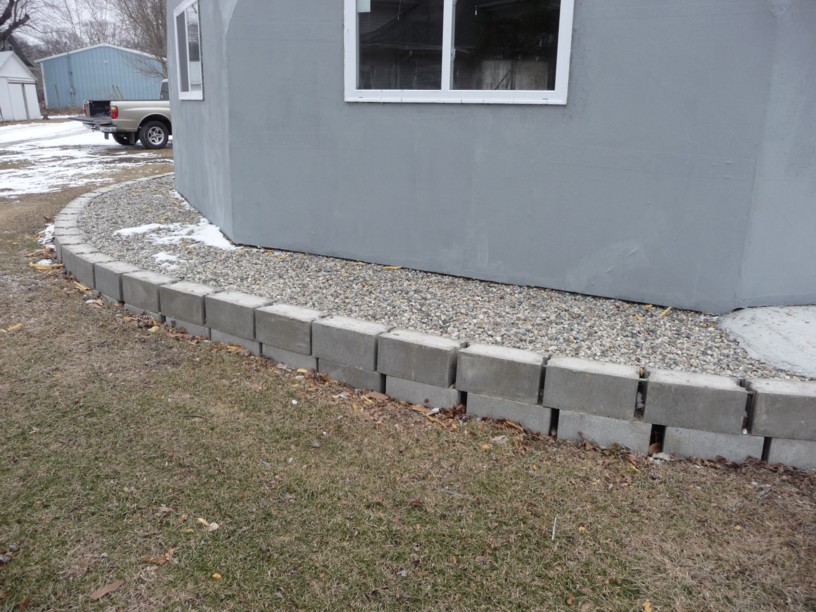
As you can see, the raised gravel mesa keeps the building dry and allows for proper drainage.
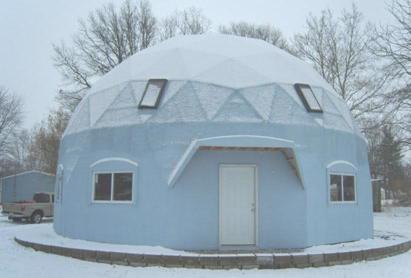
A mesa foundation creates an attractive perimeter that stays dry.
We at Faze Change Produx feel that a comprehensively designed and spacious dome home
can give one an uplifting feeling, and, also be--more--economical, energy efficient, and storm tolerant.
Please feel free to phone 217-728-2184 to discuss your green dream dome home.
By Wil Fidroeff, co-creator of the EconOdome building system.